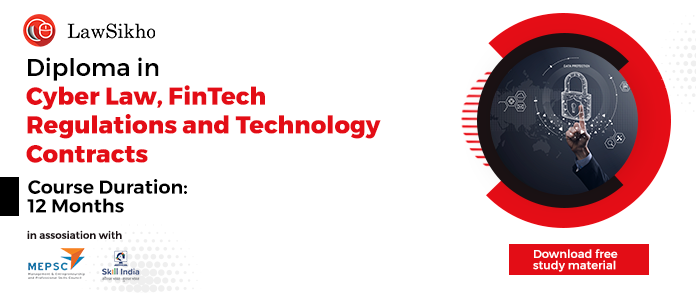This article has been written by Jasmeet Kaur, pursuing a Diploma in Technology Law, Fintech Regulations and Technology Contracts and has been edited by Oishika Banerji (Team Lawsikho).
It has been published by Rachit Garg.
Table of Contents
Introduction
Whenever any area starts advancing, it comes with a need for its laws because as much as it will be used in a bona fide way people will have mala fide intentions for the same. Similar to how the need for civil laws arose when civil disputes first occurred and how specific laws were created to address crimes against women, technology laws also emerged in response to the boom in technology. The same is true of intellectual property rights (IPR), whose necessity arose as intellectual innovations advanced and led to the 1995 implementation of Trade Related Aspects of Intellectual Property Rights (TRIPS) In this article, the author deals with what exactly is intellectual property, how it all started, it’s position in the world, role, and impact in India.
An insight into the TRIPS Agreement
TRIPS was introduced in the last round (8th round) known as the Uruguay Round of The General Agreement on Tariffs and Trade (GATT). It was after GATT, that WTO was established. In this session, discussions were held for the 1st time related to intellectual property rights, services, and agriculture.
World Trade Organization (WTO)
WTO deals with the rules and functioning between nations and makes sure that the functioning is smooth, predictable, and ethical. Countries or individuals are prohibited to steal information from others and WTO also ensures that various agreements that have been formulated are implemented and resolves disputes, if any. The most effective agreement to date is TRIPS.
So, the role of WTO is,
- Formulation,
- Negotiation and,
- Implementation of new trade agreements
TRIPS is an agreement by the World Trade Organization (WTO) whose members are 164 countries, which means around 90% of the countries of the world. It is covered in Annex 1C, which is divided into 7 parts from General to Final Provisions enlisted from Articles 1- 73. It desires to reduce impediments and distortions in International trade and to make sure that intellectual property rights are adequately protected.
Role of the TRIPS Agreement
TRIPS plays a very important role in safeguarding intellectual property rights which are given from Part II to Part V of Annex 1C.
Part II undertakes standards, scope, and usage of the following intellectual properties-
- Copyright and Related Rights [Section 1, Article 9-14]: Copyright extends to literary works, cinematography, music composition, and software development to protect the interest of people related to these fields. With the Berne Convention, only expressions are protected and not procedures, ideas, or methods. The term of Protection of a person is 50 years or till natural life.
- Trademarks [Section 2, Article 15-21]: Any sign or symbol which distinguishes a product or service is protected by trademarks. For instance, the Logos of Nike and Adidas differentiate both products. So, no other company can use the symbol which is already trademarked by another company because that becomes his/her intellectual property which they formed by using their intellect and deserve to receive monetary benefits from the same. The term of protection should be at least 7 years with no bar on renewal.
- Geographical Indication [Section 3, Article 22- 24]: We all have heard the words like Banarasi Saree, Darjeeling Tea, and Alphonso Mango, but ever wondered why are these known by their geographical area, do they have some special rights? Can anyone from any state name their tea Darjeeling Tea? The answer is no. These are known by their geographical area because they have a special GI Tag (Geographical Indication Tag) which prevents any other member from selling their goods by the name of that territory.
- Industrial Designs [Section 4, Article 25-26]: Protection is also given to Industrial Designs which are original and new (sometimes not owing to some conditions) which bars any other member from copying, making, or selling such articles, especially for commerce. For instance, no one can copy the design of Honda City without prior permission from Honda. The protection is given for 10 years.
- Patents [Section 5, Article 27-34]: Patents are a form of protection given to scientific or technological inventions as these are intellectual properties and their monetary benefits should be given to the members making innovation.
- Layout-Designs (Topographies) of Integrated Circuits [Section 6, Article 35- 38]: With 10-15 years of protection, it renders unlawful the selling, importing, or distribution of layout design which is protected.
- Protection of Undisclosed Information[Section 7, Article 39]: With the increase in competition, Unfair Trade Practices are also increasing, so it becomes the duty of members to prevent the information from getting disclosed. It not only applies to private entities but also to government or government agencies.
- Control of Anti-Competitive Practices in Contractual Licenses [Section 8, Article 40]: Some license practices are such that the conditions imposed upon them restrict the dissemination and transfer of technology relating to intellectual property.
Part III deals with the enforcement of civil, criminal, and special matters related to intellectual property. These rights are provided to prevent infringement and thereby conduct fair trade. Although unnecessary restrictions are to be avoided. Injunctions can also be imposed on the deterrent party. Part IV relates to acquisition and maintenance, and Part V to the prevention and settlement of disputes.
Scope of TRIPS agreement in India

TRIPS agreement plays a significant role in IP laws globally, especially in patents. TRIPS poses protection to intellectual property for a specified period and makes it difficult to obtain patents. Although the laws were simple with patents in India and some like developing countries before the introduction of TRIPS, scenarios changed after its advent. The scope of TRIPS can be studied in the Indian Pharmaceutical sector with its impact on the health of the public.
There is an emerging need for the pharmaceutical sector in India due to its growing population. As per the provisions of The Patents Act, 1970, the production of generic drugs and importation of patented drugs were allowed at lower prices which were later amended with the introduction of the TRIPS agreement to The Patents Act, 2005. As per the amended act, inventors are obliged to share complete details of their inventions which restrict others from making, selling, or importing them for 20 years.
In the case of Roche vs. Cipla 92012), a dispute arose between the healthcare company of Swiss and an Indian Pharmaceutical company over a drug named ‘Erlotinib’ which was used for treating Lung Cancer and was patented by Roche and was selling it by the name ‘Tarseva’. Justice Bhatt of Delhi High decided this case and rejected a temporary injunction filed by Roche against Cipla for manufacturing the same drug even though it was patented because,
- Roche’s drug was thrice more expensive
- It was against public policy
Impact on pharmaceutical sector
As already discussed, TRIPS poses several restrictions on patenting of generic drugs by giving protection to the innovator as it is believed that the innovator should be the person to enjoy benefits arising from it and if everyone will be copying that idea, the benefit won’t be available to the innovator. It is evident that affordable medicine is one of the major concerns in India whose substantial population lives under the poverty line and prices of medicines are such that are not affordable by them, so to assure absolute access to health services, the following implementations have been made by India:
- TRIPS flexibility
- Effective utilization of Compulsory Licensing.
Furthermore, the Indian judiciary is attempting to strike a balance between-
- Rights of Patentee and,
- Fundamental Right of Health
Impact on access to medicines
As Sec 3(d) is removed, it is now easier to obtain patents relating to modifications of drugs, or incremental innovations of known substances but according to the decision of the Supreme Court in the case of Novartis Ag vs Union Of India & Ors (2013) commonly known as the Novartis case, the manufacturing or production of the cheaper version of generic drugs which are patented are now harder. The companies try to get their medicines patented forever by making minor changes that do not have any increase in therapeutic efficacy as well. This concept of forever patenting, i.e., extending the patent life of a drug again by additional 20 years is known as ‘patent evergreening’ which needs to be regulated.
This decision was taken into account by the Novartis Case itself in which an application was filed by the International Pharmaceutical Company, Novartis AG before the Madras Patent Office for grant of patenting a drug named ‘Glivec’ (an Anticancer drug). But the application was rejected by Madras Patent Officer on the grounds that it lacked novelty as the patent for another drug by the name of ‘Zimmerman’ already existed and its therapeutic efficacy is not more than the original drug. Although 2 writ petitions were filed in Madras High Court and by Special Leave Petition in Supreme Court respectively, the application was rejected to avoid the evergreening of patents.
Impact on innovation
There is a mixed impact on Innovation in India. On one hand, more patent applications are being filed due to the introduction of the product patent and on the other hand, removing Section 3 (d) led to compulsory licensing which authorizes a third party for making, using, or selling of patented drugs without the consent of the patent owner.
The conditions under which a compulsory license can be granted have been given under Section 84 of the Indian Patents Act, 1970. These are:
- Public requirements have not been satisfied
- The price of patented invention is not reasonable
- The patented invention has not been used in India
One of the leading cases here is Natco Pharma Ltd. vs. Bayer Corporation (2013) in which the Pharmaceutical Company, Bayer contended that it has patented rights on the ingredient used to treat kidney and liver cancer known as ‘Nexavar’. But Natco Corporation applied for its compulsory license as per Section 84 of the Indian Patents Act, 1970 that Bayer Corporation failed to meet public demand for supply of medicine.
The controller observed that the price of drug is Rs.2,80,000 per month which is not affordable by every individual, so Bayer could not cope with the affordability of the drug thereby being unable to fulfill the public demand. The controller further observed that, since Bayer was not manufacturing drugs in India even after 4 years, thereby fulfilling the conditions of Section 84. So, compulsory license was granted to Natco Pharma Ltd.
Conclusion
TRIPS agreement has transformed the regulation and implementation of IP laws in India as well as across the world. There is no doubt that no previous agreement has shown the result that TRIPS had. Further, this agreement is important because it gives members their rights and prohibits others from using their innovations and ideas thereby protecting their monetary interests. Also, it plays a major role in India which has been discussed above.
References
- https://www.wto.org/.
- https://lawbhoomi.com/f-hoffman-la-roche-ltd-v-cipla-ltd-2012-delhi-high-court/.
- https://blog.ipleaders.in/all-you-need-to-know-about-the-trips-agreement/?amp=1#How_it_all_started
Students of Lawsikho courses regularly produce writing assignments and work on practical exercises as a part of their coursework and develop themselves in real-life practical skills.
LawSikho has created a telegram group for exchanging legal knowledge, referrals, and various opportunities. You can click on this link and join:
Follow us on Instagram and subscribe to our YouTube channel for more amazing legal content.












